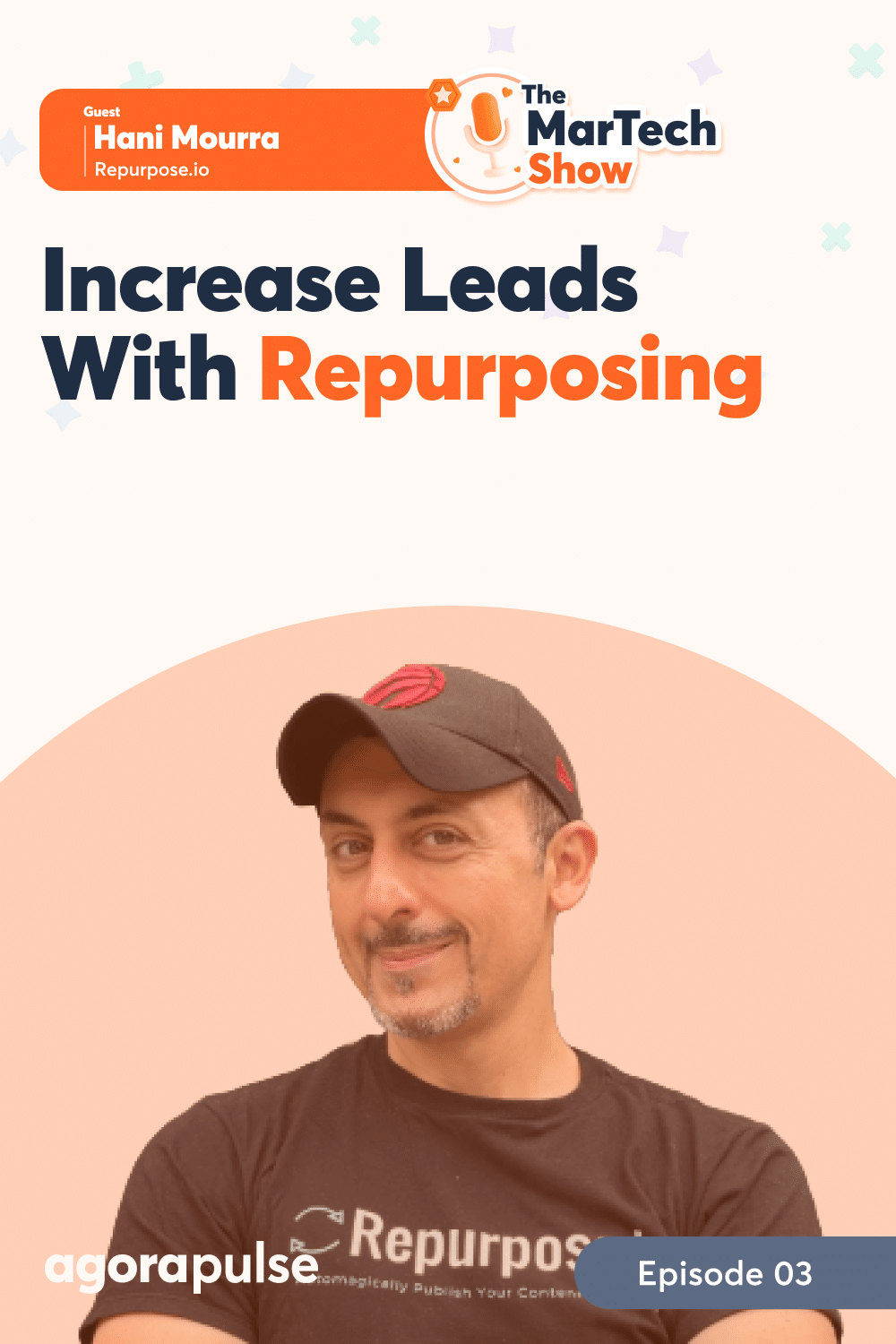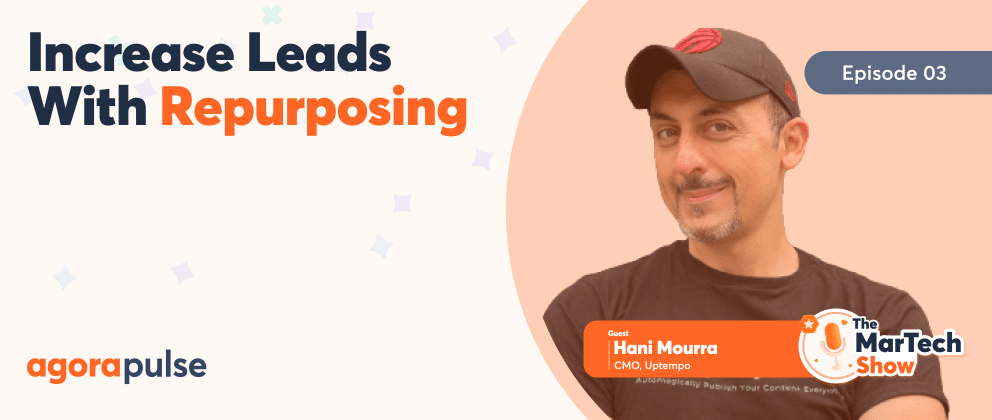Are you struggling to maintain a consistent and active social media presence? Are you spending a lot of time creating great podcasts or video content but then find yourself with not enough time to promote those new episodes?
I know how hard it can be to carve out even more time to talk about your latest post or episode when you’ve already devoted hours to it. But the fact is that distribution is the most important piece. As Mark Schaefer put it, the economic value of content that isn’t seen is zero.
So, how do we make sure that every great piece of content is shared and repurposed?
That’s what we’re covering in today’s episode of The MarTech Show, hosted by Agorapulse’s head of Strategic Partnerships, Mike Allton, and Robin Dimond. You can listen to the entire episode below or read on for the transcript of the conversation with guest Hani Mourra.
Hani is a dad, husband, CEO and a founder of Repurpose.io, an easy-to-use automation tool that has helped hundreds of thousands of influencers, content creators, businesses, social media managers, and digital marketers maximize their exposure without spending hours publishing to multiple platforms. He’s extremely passionate about creating automation tools to help content creators grow their online presence.
Mike Allton: Now, one of the use cases we’re seeing more and more with AI is to help create and change up content from summarizing articles to determining the most engaging aspects of video or a podcast to clip out.
What should and shouldn’t we do? What are the best practices in creating these kinds of derivative content? And how can we save time while doing it?
What Is Repurpose.io?
Hani Mourra: Repurpose.io is an automation tool designed to help content creators post their content once to one platform, their favorite platform, their go-to platform, and have it automatically distribute out to all their other platforms without doing any extra work.
The focus of Repurpose is the automation piece. It’s got other tools in there. You can do clipping, you can clip long form to short form. You can convert audio-to-videos, videos-to-audio.
But the biggest use case, the biggest driver, is the hands-free operation of being able to just post your content to your favorite platform and then automatically watch it go out everywhere else.
That’s why I started it. It’s honestly a dream tool. And I’m just a weird person saying, “I wish I could just make the content once and put it out there. Why do I have to upload it to so many platforms or upload it to different tools? I just want to be able to post it and let it go everywhere.”
That’s kind of always been my motto. I say lazy, efficient, as loose terms.
Preserving the Humanity in Automation
Robin Dimond: Can you please tell everybody, with these days with so much AI and automation, how can we start talking about incorporating the human touch? And where does that go?
Why are creators essential to this whole process?
Hani Mourra: The actual content of your video—let’s say 80-90 percent of the time—it should be you. It should be the person. It’d be a human-to-human interaction at the whole point of the video. Why video is popular ever since YouTube and before YouTube, many, many years ago, is because you feel a connection with that person.
If you’re using AI to simulate yourself or simulate other people talking, they might work in the short term, maybe for a couple of videos, but I feel like the authenticity is lost.
You need you as a person, as a creator, whether it’s you or someone in your company or your business. Like, it has to be a real person talking to another real person who’s watching that video.
I think for me, that’s the number-one priority for any piece of content that is human-to-human connection.
And definitely, AI is there to help. AI’s role, in my books, is to help you come up with maybe some idea generation, maybe some help you script some of your content a little bit better or format it. Maybe helping you choose some clips.
AI is an assistant, not the main creator of your content.
You can’t rely on it a hundred percent. It gives you some guidance, some ideas. And sometimes when you’re stuck in a rut and you don’t know where to start, it sparks that creative process a little bit, it gives you ideas, and then you roll with it, and you make it yours.
Repurposing vs. Distributing vs. Reposting
Mike Allton: Now I know Repurpose.io does a lot of different things, but can you clarify the difference between repurpose and distribute or repost and when a brand might use one or the other?
Hani Mourra: Repurpose.io is almost like a Swiss army knife. We talked about it a bit in the intro. You can do audio-to-video, video to audio, all kinds of reshaping, and reformatting.
My definition of repurposing is taking a piece of content and changing its format, like transforming it from one piece to another. For example, you have a long video, you turn it into a short video clip that you can post on Reels or TikTok or YouTube Shorts.
You have a video. You can turn it into an audio podcast. Take video content, turn it into a blog post. Those are my definitions of repurposing. You’re transforming that content. And, of course, once you transform it, you want to distribute it. So if you are creating short-form videos, you’re going to be using a lot of different platforms.
Distribution is obviously what it says. You’re pushing it out everywhere to all the platforms. Some people use the word repurposing, and it’s more tied to reposting, but I feel it’s equally or even more important, especially these days where short-form content is the biggest thing that’s happening right now in terms of people’s attention.
So, if you’re creating short-form videos, you can keep it super-simple. Just take that short-form video, post it to one platform, and then repurpose can push it out as it is. Essentially reposting it as it is to all seven, eight, nine, ten of your other platforms.
I don’t like the idea of reposting the same content on the same platform over and over again. I know some people do that. I’m not a big fan of it, but I feel reposting and redistributing your content that’s living on one platform and have it posted on another, it’s critical. You want to be everywhere and you don’t want your audience to come find you on one platform.
You want to be on the platform they’re already hanging out on.
What are the benefits of automating this distribution to this level?
Hani Mourra: The biggest benefit our users have has always been the mentality of when I created the software probably eight years ago now was don’t change the creator’s habits.
You don’t want to force a creator to say, “Okay, upload your content to my tool here, and then I’ll push it out everywhere.” You know, what if you don’t want to do that? What if you’re on the road, you shoot a piece of content, especially nowadays with short form, you shoot on TikTok? They have beautiful editing tools right on the TikTok app, stick a couple texts, video, whatever, and just post.
Like, you just want to be able to post natively on that application, whether it’s TikTok, whether it’s Reels, whatever your favorite platform is. When you do that, and then we designed Repurpose, so it takes the content from that platform automatically and pushes it out everywhere else. So you don’t change your habits, but you also just focus on your go-to platform and then have it go out everywhere else automatically.
You don’t even need to log in to Repurpose. To do that, you can have everything, set up on autopilot, and it just happens within an hour of you posting on TikTok. It’s going out, it’s shooting out to X, to LinkedIn, to Pinterest, to YouTube Shorts, to Instagram Reels, without you having to even worry or think about it.
That’s the main advantage, of the platform that we’ve developed. That approach of “don’t change your habits, focus on, just do what you do, and we’ll take care of the rest.”
Using Repurpose for Different Posts
Mike Allton: Walk us through what we would be doing here because here, with this show, is filmed as a live webinar. Afterward I download the recording. I upload it to a Google Drive, which I think you can see. and then I’m personally going in and taking a couple of clips out like this afternoon. I use iMovie because I am not advanced at all in my editing skills. And then I’ll push that out to TikTok and Instagram and so on. If, the clip is short enough, how would we insert Repurpose into this process?
Hani Mourra: With Repurpose, we don’t connect directly with StreamYard, but if this is being streamed to, let’s say, Facebook or YouTube, actually.
- You can connect those platforms to Repurpose.
- And then you can make what we call a workflow—I call it a magic recipe—that says, “Every time there’s a new video on YouTube, I want you to send it over to Facebook,” or to whatever other platform you want to.
- In this case, we don’t want it to send it because we’ve got to chop it up.
- What we do is you make a YouTube workflow to, let’s say, X. You want to send a clip to X, so you make that workflow. You go inside, you’ll see all your videos appearing automatically inside Repurpose. Pick the one that you want. We have a quick editing tool that you can come in and chop it up really quick. (That’s something we’re actually improving over the next few months that uses a little bit more AI to help you with that process. Right now it’s manual, but coming soon, it’s going to be automated where it would recommend the clips for you.)
- For now, you pick the clip, and then you can apply a nice template to it and then schedule that piece of content to X.
- Then you would do the same thing to all other platforms.
- The pulling it in from the different platforms is already a part of Repurpose itself. So, that’s taking the long form into short form.
- And in a similar process, if you were doing short form, if you’re doing TikToks already, similar, probably hook up TikTok, you hook up Instagram, build a magic workflow. And every time you post on TikTok, in that case, because it’s already a short form, you can have it automatically go to Instagram Reels without you even having to click any buttons.
- We have two modes of operation, manual and auto.
Mike Allton: You mentioned you can see TikTok and Instagram. What is the list of platforms that your tool can see and then do an automated workflow after that? There’s a new piece of content there.
Hani Mourra: Yeah, great question. So we call them sources. A source is where you repurpose or distribute content from. We can go from YouTube, Facebook, TikTok, Instagram Reels, Facebook Reels, an audio podcast. You can take an audio RSS feed, hook that up, and then we can turn them into little video clips as well. We have some templates pre-built, so you can do an audio feed, a video RSS. If you’re doing a video RSS feed, Zoom, you can do Zoom cloud recordings as a source, and I believe those are the main ones. All of them, the destinations.
The other side of the thing is the destinations, right? Where do you send them to? You can go everywhere else. You can go to X, Snapchat, and everything else I’ve listed as a source is also a destination. and then, you know, Pinterest, Snapchat X, LinkedIn, it’s all your socials.
Best Practices for Repurposing and Distribution
Hani Mourra: If you’re getting started with content, let’s just talk about distribution.
That’s the simplest way.
If you’re starting or you’re doing short-form videos, I mean, if you’re just starting into creating content, I highly recommend doing short-form video.
- Keep it simple. 30 seconds. The best practice is: Keep it under a minute. Ideally, if you can get into 30 seconds or under, even better. I’ll explain why in a second, but keep it 30-60 seconds.
- Shoot it vertical. The main reason is it’s literally compatible with every single platform. So you can make these short content videos. The attention span is there because of the content. You post on TikTok, for example, or Reels, and then you can have it go everywhere without any changes or anything to that content. YouTube Shorts right now is the limiting factor. 60 seconds or less is their limit. So if you keep it under 60, you’re guaranteed to work on all the platforms.
That’s the simplest way to get started.
- Post whatever you want—but just make that content once, and keep it 30 to 60 seconds.
- The shorter the better. I think a lot of people noticed already is the percentage of the watch time of the video is one of the big factors that affect reach, ike, how much social media platforms push it out.
If you have a one-minute video and people watch the first 10 seconds, that’s a smaller percentage than a 10-second video where people watch for 10 seconds. That’s weird. That’s obviously 100 percent watch time. So the shorter you are, the more likely to watch the whole thing.
And when you watch the whole thing, then the algorithm says, “Oh, this is a good content. I’m going to show it to more people.” The caveat is: You don’t want to just have some silly videos. Maybe you do once in a while, but you want to deliver value in terms of education, information, or entertainment in that short video.
That’s best practices for short-form video.
Like I said, if you’re not creating or you’re getting started, you start with short. That’s the easiest way to get started.
And then, from long-form video, we talked about taking an interview like this (or even customer calls that you may be having or client calls that are not confidential, of course). Take them and turn them into 30 to 60-second clips that are in vertical format, and have them go out to all your social media.
The end game is short-form content. It’s what’s winning right now on all the platforms that they’re all fighting for your attention: the Shorts, the Reels, the TikTok. So whether you’re creating short or you’re taking long, and you’re dropping it up into 30-second to 60-second clips.
That’s the strategy you want to go with today.
The Benefits for Agencies
Robin Dimond: How can agencies like Fifth & Cor use this to manage so many social media accounts like you just talked about with different clients?
What are the benefits from a platform like Repurpose? What are the benefits to all the agencies?
Hani Mourra: For agencies, we work with a lot of agencies. They love it. Like, it’s a one-time setup. They connect the client’s accounts, the YouTubes, and the TikTok, and then they can just manage it from one interface.
They can manage to have it go on autopilot. If they want the content, if it’s already short, I could have the content just shoot out automatically. Or if they want to control it and go in and schedule content on specific dates and times, they can do that as well. It’s all set-up so that we even have a way to invite your clients to connect their socials without giving you your passwords. That’s another important note. But the idea is that you have almost a place where you can manage all the content flow—or we call them workflows from one place to the other for all your clients if you’re an agency.
And then if something does go wrong and you need to repost or reschedule something, you have one hub to manage it.
Risks of Automation
Mike Allton: Are there any negative impacts or risks associated with this level of automation?
Is it a bad idea to be sending the same piece of content to every social platform at the same time?
Hani Mourra: No, and to be honest, some clients have reached out to us where they’re shocked. Like, they see, “Okay, I’ve reposted all my TikToks to YouTube Shorts,” for example. And then all of a sudden they’re like, “Oh, I’m just all of a sudden getting a following there.”
I’m not saying that happens. It’s not a guarantee. But by distributing your content, you’re building your exposure on all these platforms. And sometimes what we’ve seen customers say, “Hey, this video on my original video on TikTok only got a couple thousand views, it went to Reels and then it got, you know, whatever, a couple hundred thousand.”
- Some content, the same content, will perform a lot differently or obviously a lot worse as well on different platforms.
- You don’t know every algorithm. Every platform has their own rules and how they feed that content to other people.
One negative I would say is:
- If you do get traction on other platforms, it can be a bit of a challenge to keep up because—back to the human aspect—you’re posting content on all these platforms. You’re using automation to put it out there.
- But if people are commenting on them, and you’re not responding, you’re not engaging back. It’s just not good. That’s not a good human-to-human interaction. That’s not good for your brand.
- So, you need to be able to keep on top of the comments. And even if you just say, “thank you,” just acknowledge that people comment on your content across all your platforms.
Agorapulse actually does a great way. We use Agorapulse ourselves to manage all our comments across all our platforms. And they have a great listening tool for that. So, if you want to look at it as a negative, it’s a good problem to have, but it can be overwhelming if you have interaction and track.
You got to keep bouncing back to different platforms and reply back. It’s, again, back to the human aspect of it.
Getting Results for Clients and Brands
Robin Dimond: What are some measurable results clients and brands can expect to see when they use this [Repurpose]?
Hani Mourra: I wish we had knew how the algorithms work, and we do have contacts at the different platforms because we’re a tool that integrates with our API, etc.
But it’s a big mystery.
But we do have examples. Like I said, there are a couple examples.
- There’s Andreas. I don’t know his last name. I did some pull-ups on the actual numbers. There’s a person that was named Andreas. He was posting from—I think it was TikTok or Reels, I can’t remember—onto his Facebook Reels. The automation, sometimes people forget. It’s funny. They come back and they say, “Oh, hey, by the way, I set up a Repurpose to set up, Andreas, for example, posting to Reels and I forgot about it. And a few months later I logged in and I have a few hundred thousand followers.” I think he’s at 500-5,000 followers. His videos are getting millions of views. Now he actually has over 5 million followers. This is maybe a year later from when he messaged us. Like, because of the automation, you almost forget. It’s a nice problem to have. So, yeah, like sometimes they blow up on Facebook or Reels.
- The algorithms changed all the time. We can’t say guaranteed, but Facebook Reels was peaking at a certain point. Maybe he caught it at the right time. You know, he got the traction.
- There’s Dr. Alo. He said he went from obscurity. That’s the words he used. From obscurity to 5.5 million views a month by just taking his TikToks across, I think, five or six platforms, again, on autopilot.
- I think the most recent one was Declan from MyJotBot. And again, the same thing, we’ve been using it for a while, forgot about it. I reposted a TikTok to Shorts and it got over 1.9 million views. And this was four weeks ago, so it’s probably even higher now.
I don’t want to get the impression of “Use Repurpose and you’re going to go viral.”
That’s absolutely not what I’m saying.
I’m saying is you don’t know how every platform will react to your content, so you want to get it out to as many platforms as possible.
Dripping Out Your Content Library
One thing I didn’t mention was with Repurpose, it’s not only your new content.
If you don’t have any presence on the YouTube Shorts, but you’ve been doing TikToks for two years, so you have a library of a thousand videos, you can set it up. So it drips out one TikTok video per day to your YouTube channel at 9 o’clock every day, or between 9 and 11, like a certain time window.
You’re slowly feeding your existing content. Again, on autopilot, you set it up once and you leave it.
Start building your other channels slowly.
You’re obviously not going to upload a thousand TikToks to YouTube in one day. That’s good.
So, we do have that mechanism to drip-feed your existing library, and that’s what people do when they’re moving from one platform. It’s not, say, moving when they’re trying to start fresh on a new platform, but they already have a library.
You’re not even making new content. You’re just taking that content. Set up that workflow and turn it to auto say publish one video per day and then move on with your day.
Don’t Get Stuck On One Platform
Mike Allton: Hani, that is huge.
We’ve got a lot of people that are really concerned right now because the Senate just passed legislation at the time of this recording to ban TikTok in the United States. They’re going to be challenged legally.
The timeframe is not what you think it is, but Biden’s going to sign that into law tonight. [Editor’s note: when this interview took place.]
And so TikTokers are rightly frightened that all the time that they’ve spent creating a TikTok audience and all this content is all for naught.
So you’re saying, “Hey. Hook up Repurpose.io and you can start dripping, maybe a little faster than one per day, but you can start pushing all that video content out to Facebook Reels, Instagram Reels, YouTube Shorts if they’re short enough. Remember, under 60 seconds today for YouTube Shorts.”
That’s incredible.
Hani Mourra: Not only that, but we also have Google Drive and Dropbox, so you can back up all your TikToks onto your own Google Drive or Dropbox.
That way, you have a complete backup of your entire library, especially nowadays with this goes through in the next few months. You don’t want to be like, “Oh, I can’t even access my own content. It’s gone.”
You have a high-quality video, watermark free on your Google Drive that is yours to manually do whatever you want with it. You own it. A lot of people actually use that to back up their content from TikTok, Instagram, from YouTube. Again, TikTok can get banned. Maybe YouTube doesn’t like your content, and you get flagged.
You want to use your content, you created it, and you want to have it. So a lot of people use Repurpose on top of distribution and as a backup tool as well.
Mike Allton: That’s huge. I knew you had Google Drive integration. Is that destination only, or is that also a source?
Hani Mourra: It’s both. So you can drop in a file in Google Drive and then say, “Hey, take this video from Google Drive, from this specific folder, shoot it out to this platform or that platform, or vice versa.” You can say, “Take my TikToks, and back them all up to this folder on Google Drive or Dropbox.”
It works both ways.
And just that alone is worth it.
It’s so valuable. Just that one piece, get that set up. And not only can you back up your entire library, then you know, going forward, every time you post a TikTok it’s going to get backed up. So you don’t have to keep backing up. It just automatically, you back up all my existing content plus anything going forward.
Robin Dimond: You really are a Swiss Army knife.
That’s amazing. And we really can’t appreciate that enough.
As people are watching this, go back and listen to what Hani said. Break apart this video.
You’re going to listen to it one time and like, “Whoa, that’s great.” Go back and listen to it a second time. And I want to say this, it’s because, as a business owner, as an agency, we’ve seen the greatest things. People get adopted. We’re seeing a lot of companies come and buy out people as well. And so they need all of that video content. They need to move it over to another channel. Private equity is coming.
If you’re ever looking at selling your business or getting investments, this is a great solution to be able to go after repurpose, get that Google backup, but then also be able to distribute it a different way.
Maybe start a new product like we are, and you get to actually be able to use this across different channels. the other thing is using those old videos, and I want to go back to that: using your old content. It hits differently.
If I use a different workout, it goes back and you just start doing something totally different. You get the better results. And so that is pretty powerful that you said that.
I really appreciate you sharing that and everything you were able to share with us today.
Hani Mourra: We’re everywhere. Obviously, that’s what we do. We’re in the business of being everywhere. So we’re @Repurpose.io pretty much everywhere. I’d say Twitter, Pinterest, Snapchat, even, YouTube, Facebook. We’re everywhere.
Thank you for listening to another episode of the MarTech Show hosted by Robin Dimond and Mike Allton, powered by Agorapulse, the number-one rated social media management solution, which you can learn more about at Agorapulse.com. If you want to make sure you’re part of our audience during a live weekly broadcast, take a look at our calendar, or click the subscribe button in your email once you register.






